INTERVIEW
Darren McManus
Born
in 1976 to an Irish father and Italian mother, Darren McManus spent the first
18 years of his life in a small southern New Hampshire town. A scholarship B.F.A.
graduate from the Hartford Art School in Connecticut, his junior campaign was
spent overseas studying at Scotland's Glasgow School of Art. McManus later earned
his M.F.A. from the Cranbrook Academy of Art in Michigan. A Galaga and Centipede
whiz, he's also extremely skilled at jigsaw puzzles and recently ran his first
marathon. Aside from the interests contained within his paintings, other fascinations
include cacti, baseball statistics, fresh water fishing and
fruit salad. | |
|
MT>
Obviously, you prefer to paint using acrylic on wood. Are there other mediums
that you have used or would like to impliment into your artwork? Have you considered
sculpture or another art process to express your love for gaming?
DM>
To answer the first part of the question - yes, I have used other media in the
past. In fact, most of my work prior to attending graduate school was executed
in mixed media. During this time, I did not have the luxury of having access to
an enormous studio space and this influenced both the scale of my work and my
materials. In addition, much of the work I created during that time was predicated
on my decision to begin a career as a freelance illustrator. As a result, I worked
primarily on cold pressed illustration board combining various wet and dry mediums
- gouache, ink, water color, collage, technical pens and colored pencils. What's
interesting is that I have recently been utilizing these mediums again as a way
to quickly generate new ideas for future compositions and/or to possibly function
as a supplementary body of work that both challenges and informs my larger paintings.
As for implementing new mediums, I would have to answer "yes" to this
as well. I am constantly investigating different materials and methods of application
within my studio, but I will include these discoveries into a piece only when
I feel confident that the work will benefit from the decision.
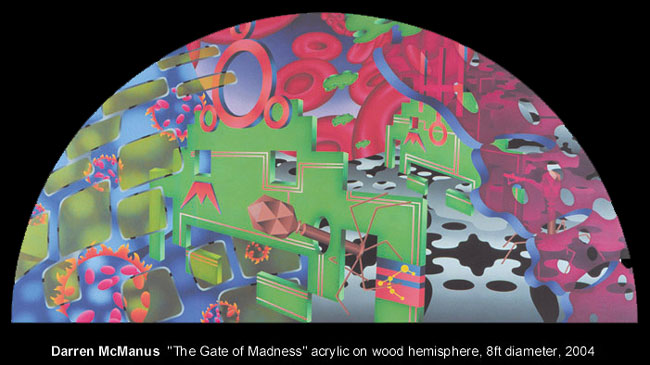
MT>
Have you considered sculpture or another art process to
express your love for gaming?
DM>
Yes. In fact, I was working
in a type of relief/assemblage technique when the idea of incorporating "gaming"
concepts first entered my mind. However, I only finished a couple of pieces in
this vein before switching to the airbrush and strictly 2-D creations. Painting
is still such an extremely new and exciting realm for me that I think it's a safe
assessment to state that I have my hands full - creating a
3-dimensional
illusion on a 2-dimensional surface is compelling enough for me at the moment.
MT>
Many of your pieces are either 4 ft or 8ft in diameter and
are created on a full or half of a hemisphere. Why do you prefer this size and
layout format?
DM>
Although the circle and hemisphere
structure is a preference, the size of the works did not initially begin as such.
I did not fabricate the first installment of wood structures, rather I acquired
them via a stroke of good fortune. However, I think it's a fair assumption to
state that the diameter of the large lunettes was dictated by the 4 x 8 foot standard
for most sheets of lumber - making them the maximum size obtainable from one single
sheet. Thus, it follows that two of the 4-foot circles can be made from another
single sheet. At any rate, the decision to start working on circles and hemispheres
crystallized after I finished my first piece using the airbrush. It was a rectangular
painting titled, "Journey to the Heat Death." In many ways, the process
of creating this piece symbolized the "death" of several components
of my working methodology up to that time, but it also facilitated the "birth"
of numerous amendments. I have long been fascinated with the various symbolic
interpretations of the circle (especially the inherent cyclical nature of which
I just touched upon), so the decision to work on circles and hemispheres was largely
fueled by a desire to better acquaint myself with these forms. I started working
on the half circles first. As I was working on them, I began to think specifically
about the universal acceptance, understanding and use of geometric shapes and
symbols across cultures and throughout history. I find it fascinating that the
circle seems to be the ultimate paradox. It has been assigned the designation
to represent an abundance of opposing forces and/or concepts stemming from very
basic in nature to those of an extreme complexity. So I decided that the hemispheres
would be a decent way to physically represent this dichotomy while possibly lending
some influence to the work itself. I had two of the structures hanging adjacent
each other on my studio wall - one with its' diameter functioning as the baseline
and the other its 180 degree equivalent - arc side facing down. The first seemed
"normal" or "familiar" to me while the latter appeared "upside
down." This evoked a certain degree of discomfort (both visually and intellectually)
and left me pondering notions of incompleteness and disharmony. For me, this only
solidified the archetypal nature of the circle as a symbol of unity, wholeness
and/or the cycles that contribute to such a state. In showing the circle bisected
as a lunette, the idea of the complete circle becomes a concept almost impossible
not to imagine - simply by viewing part of the whole. In relation to basic shapes
and symbols, this inherent duality seems only to exist "within" the
circle - as when a square is bisected and the two resulting rectangles are viewed
in juxtaposition, one does not innately ask, "Where is the other half?"
MT>
What era do you think that your paintings reflect? Primarily
classic gaming concepts, more modern day or somthing in-between?
DM>
I think that they portray a hybrid of different eras of the gaming realm, but
this has been a gradual process based on conscious decisions. Before I started
exclusively using the airbrush, I was making these strange relief / assemblage
paintings in graduate school that were harboring constructive-criticism in directions
that I had not intended. This was evidence enough that I needed to further unify
my entire creative process in order to assure that these inaccuracies were not
so commonplace when investigating the work. My interest in the visual language
of the gaming realm actually stems from the layout schematics of board games that
I can recall from my childhood - games like Candyland, Chutes and Ladders, and
Parcheesi. I chose to use the concept of the flat, 2-dimensional game board as
a compositional device that would help dictate how the elements within these paintings
would (co)exist. However, at this time, I wasn't directly culling specific imagery
or schematics from particular games and thus, the connection was too ambiguous
and a large portion of my intended message went unnoticed. Then, late one night
/ early one morning while working in my studio on the first large lunette piece
"The Seeker's Search Begins," I had sort of a Eureka! moment.
As I just mentioned, gaming imagery and concepts were already part of my visual
repertoire, but I had been struggling with how to incorporate my interests that
were of a more obscure nature. That particular evening, it was my life-long fascination
with Ufology. My dilemma was with how to represent this topic (or aspects of)
in such a way that would be accessible to my potential viewership. All of a sudden
it popped into my head - Space Invaders. Besides the obvious correlation
with their very name, the idea of using these characters as surrogates for all
things extraterrestrial seemed like the perfect "win / win" solution
to my dilemma. At face value, they are globally recognized as classic gaming icons
while their very structure simultaneously pays homage to their own lineage (or
DNA if you will) - the pixel - also an increasingly influential element in contemporary
painting. On the other hand (and perhaps less obvious), is the argument that Space
Invaders have permeated pop culture on a global scale so thoroughly because
they do represent the unknown, the unexplored and the possibility of "What
if?" This inherent double meaning is the sort of paradox that fuels most
of the imagery or scenarios within my paintings - some are obvious and others
are shrouded in mystery. So at that point, my mind was off and running on this
perfect tangent…
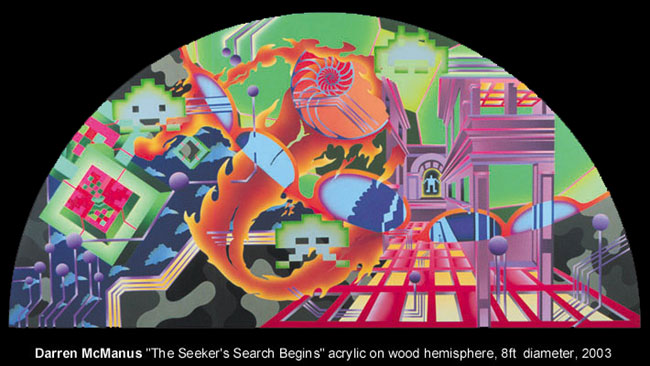
About
3 weeks later, upon what I thought was the completion of the piece, I stood looking
at it and realized that although there were remnants or hints of humanity, there
was no direct attempt at portraying the human form (and I felt there needed to
be.) That's when another light bulb went off further connecting my work (and imagery)
with the history of video games…
In 1974, scientists working for
SETI (Search for Extraterrestrial Intelligence) in Arecibo, Puerto Rico blasted
a transmission into deep space with the hopes of it eventually being intercepted
and deciphered by extraterrestrials. The portion of this transmission designed
to represent human life mirrors that of the protagonist in numerous classic video
games including Atari's "Beserker" and "Tron."
That being said, I appropriated this pixel representation into that painting and
despite its small scale, it managed to completely shift the dynamic of the piece.
Appearing to be on the verge of critical mass, everything within this apocalyptic
nightmare now seemed to possess a certain causality with this human form and its
precarious position within the environment. Subsequently, this "pixel person"
has found a leading role in my cosmic narrative. There exist other, less obvious
facets of the gaming world in my work as well. For example, in using the sequencing
of exact base units (hemisphere and circle structures), I have directly mirrored
the repetitive, segmented, serial nature of the video game narrative. The basic
idea is that each painting offers a new tangent in my cosmological puzzle. They
act as detours and / or warp zones that do not necessarily follow a linear progression,
but in fact, encourage a reinvestment of thought and experience. I would like
people to begin creating his or her own relationship with this "pixel person"
much akin to the hyperpersonal connection one has with a character when playing
a video game. In addition, I have begun to investigate issues of gestalt in the
form multiple vantagepoints and perspective impossibilities, both predominate
characteristics of the gaming realm. Hopefully this answer has explained what
I meant by stating that my work incorporates a hybridization of gaming concepts
from numerous eras.
MT>
Do you ever supply a background story to set an image in a certain perspective,
or do you mostly let the viewer's imagination immerse themselves into your artwork?
DM> In the form of an actual text document - no. As a painter, I understand
that I will not be present the majority of the time when another person views
my art. The lone option (if desired) is to supplement the work with a brief artist
statement. I like to think of this document as a way to simply get the viewer
intrigued about my work. It's not my idea to explain every nuance of my paintings
via the artist statement, but rather to entice the viewer into a more thorough
investigation of my intentions and objectives. The references and topics that
fuel my work are as diverse as they are eclectic and this seems to present quite
a fertile landscape for the viewer's imagination to roam and begin his or her
own set of interpretations. There is definitely an underlying theme or story (if
you will) throughout the work that I have created over the past several years,
but it's not a preordained narrative, rather more like what I mentioned in the
previous answer - a mutating cosmology.
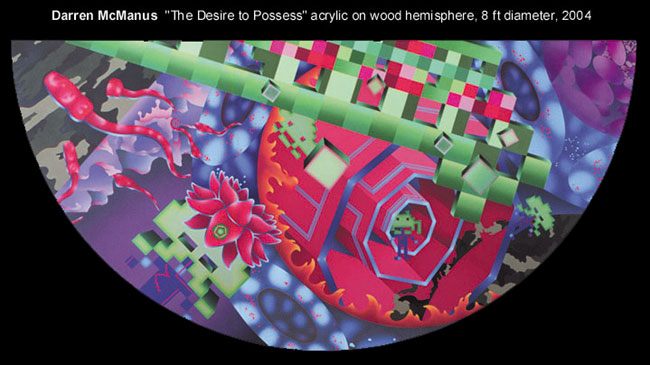
MT>
Have you had any gallery exhibitions?
DM> Yes. However, since completing my M.F.A. I have been focusing on a new body
of work (based on all the ideas previously mentioned) and hopefully they will
find their way into a gallery or two in the very near future.
MT>
Your videogame themed pieces have found their way into DaimlerChrysler's corporate
headquarters, as well as individuals collectors from as south as Florida and as
north as New York. Even Sammy Studios (current owners of Sega) have appreciated
your work. Is there anyplace that you would really like to see your artwork to
be displayed - the Louvre perhaps?
DM> At this stage in the game (pun intended), my M.O. is to keep pushing my own
limitations while creating a body of work with the hopes that it will lead to
exhibitions and possible gallery representation. In all honesty (and partly because
I have a nonconformist streak), I would really get excited about my work being
included within the confines of any holy edifice - be it a church, cathedral,
mosque, etc. That, or any other venue where it would receive widespread viewership.
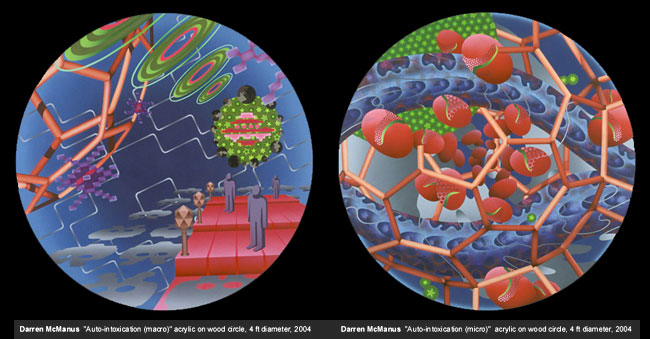
MT>
Are you able to calculate your physical costs for a project?
This includes materials for creation and manual hours of labor to create any given
piece of artwork?
DM> In a guesstimate sort of way, yes. However, I'd
probably grow glum if I were to log an accurate running tally of the money I spend
on supplies and project related munitions, so this is something on which I try
not to dwell. However, for the sake of curiosity (and this interview) let me attempt
a figure. I am currently working on six four-foot circle pieces which manifest
from the following: wood, glue, sand paper, primer, x-acto blades (why are these
so expensive?), paint and new air filters for my respirator. In addition, there
are components of the airbrush that may or may not need to be replaced throughout
a series of paintings such as needles, springs, and tips. I would round off my
total for supplies somewhere between $650 and $750 for these six pieces. Finally,
I've had to spend about $500 over the past several years for clamps, power tools
and various accessories. In terms of man-hours, my paintings are on the laborious
side. Being that I can not afford to have the structures made by somebody else;
I invest close to 40 hours per structure simply on construction and prepping the
surface. An eight-foot hemisphere painting takes between 300 and 350 hours while
the smaller four-foot circles need roughly 150 to 200 hours. However, each piece
results in new short cuts and techniques that expedite my working process. Overall,
I enjoy becoming immersed within the task of finishing a piece, as the process
becomes quite meditative and revealing.
MT>
So, what is your next project?
DM> As previously mentioned throughout the interview - right now, I'm heavily
invested in the idea of creating this elaborate, complex cosmology with the idea
that each new painting builds upon it's predecessor and/or represents a viable
tangent from what existed before. So, to answer your question, it's an on-going
project that started several years ago and I don't foresee any finish line ahead.
Which is a very good thing in my opinion because I'm completely interested in
the concept and it provides for what seems to be an infinite amount of possibilities.
Aside from my paintings, I have been trying to put down more of my ideas on paper
in the form of small, "less finished" offerings. This combats becoming
overly consumed with simply the larger paintings. These works on paper are starting
to serve as building blocks or sounding boards for new techniques and concepts
for the larger paintings so in that sense, they are already paying dividends within
the studio.
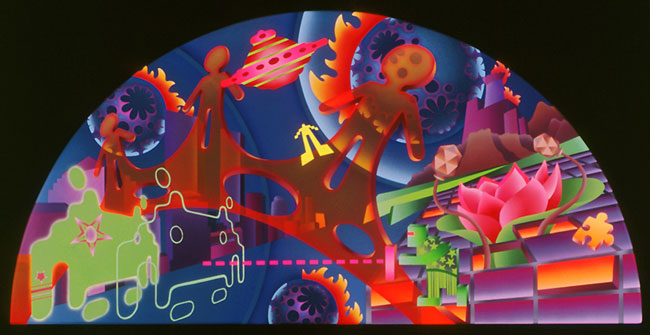
MT>
What ideas for themes do you have running around in your
head that you haven't had the time to make a reality in paint just yet?
DP> Geeze. Where do I start with this one? My process is very time consuming and
thus conducive to meditative spells that leave me free to think of new concepts
and imagery to use in future pieces while I work. At the moment, I find myself
way behind the list of "things to do" that my mind has established for
my hands to enact. A couple years ago, I realized that many of my ideas would
slip through the cracks and never be realized because I never wrote anything down
or documented my findings. The practice of maintaining a sketchbook never really
complimented my preparatory work and I think this is because for me, my prep work
is much closer to a "book work" type of research than say, the process
of making sketches and/or personal notations. Therefore, it didn't really seem
logical to "recreate" or copy what I was discovering in the books and
magazines that I was searching, so I started making photocopies and/or scanning
pages to output myself. This is a constant process for me and like my paintings,
there is a sort of maniacal order to this endeavor as well. I have scores of 3-ring
binders that are packed with all the copies, scans and texts that I have been
gathering and the collection serves as a physical representation of the ideas
in my head. Each binder is classified by the relationships that I find intriguing
about the elements/concepts found within. For instance, the Space Invader
characters are categorized within my "Ufology" binder sandwiched between
the documentation of the SETI transmissions that I previously mentioned and the
pages of "beamships" as documented by Billy Meir in his (in)famous lifelong
communications with extraterrestrials. Despite having very similar formal characteristics,
the fact that the imagery pertaining to these three topics runs the gamut from
fiction to non-fiction, to me, is utterly fascinating. It is fact that SETI blasted
transmissions into deep space. On the contrary, the legitimacy of Billy Meir's
extraterrestrial aircraft photos is still a question without an answer - hardly
passing for fact. While the imagery of the Space Invaders function
as the hybrid - they are a fictitious reality. Which, in essence, is really what
I create. I think I might have answered that question in a very roundabout manner,
so let me clarify. Although each piece is its own entity, I envision them all
belonging to the same "project" bound by my personal interests and idiosyncrasies.
I hope that I answered all of your questions and perhaps provided a decent
backdrop for what I create and how the process unfolds. If you are reading this
and would like to ask me any additional questions, please feel free to drop me
an e-mail and I will do my best to reply in a timely fashion. On a side note -
I recently created a design for a Chicago based T-shirt company. All their shirts
are hand made (screen-printed) and my design should be ready for purchase in the
very near future. Here is their website address: www.imperfectarticles.com
In the meantime, please be on the lookout for my website and take care. Thanks.
(UPDATE: All the T-Shirts are SOLD OUT)
MT>
Thank you, Darren, and good luck with your future endeavors combining Art &
Games, and all your other underlying themes.
The name Darren McMannis may
not yet be a household name, but your a d@mn good painter!





